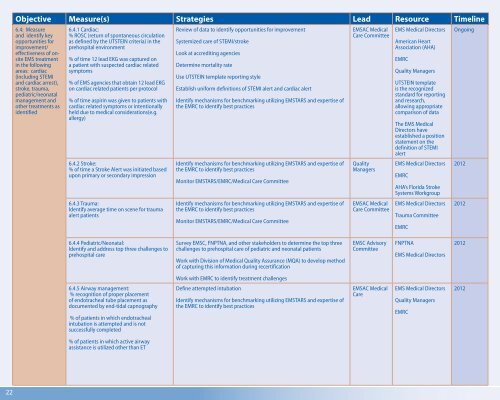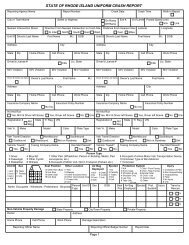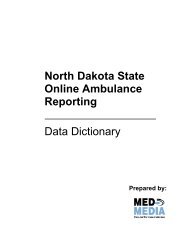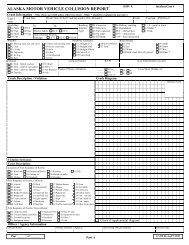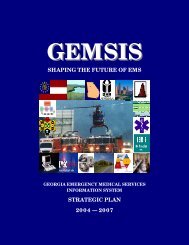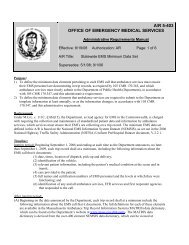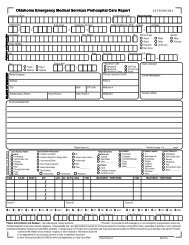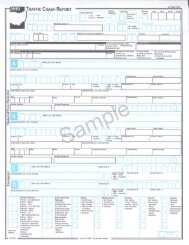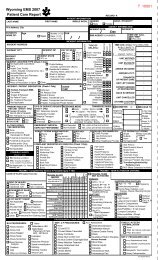Florida's Emergency Medical Services Strategic Plan
Florida's Emergency Medical Services Strategic Plan
Florida's Emergency Medical Services Strategic Plan
You also want an ePaper? Increase the reach of your titles
YUMPU automatically turns print PDFs into web optimized ePapers that Google loves.
Objective Measure(s) Strategies Lead Resource Timeline6.4: Measureand identify keyopportunities forimprovement/effectiveness of onsiteEMS treatmentin the followingareas: cardiac(including STEMIand cardiac arrest),stroke, trauma,pediatric/neonatalmanagement andother treatments asidentified6.4.1 Cardiac:% ROSC (return of spontaneous circulationas defined by the UTSTEIN criteria) in theprehospital environment% of time 12 lead EKG was captured ona patient with suspected cardiac relatedsymptoms% of EMS agencies that obtain 12 lead EKGon cardiac related patients per protocol% of time aspirin was given to patients withcardiac related symptoms or intentionallyheld due to medical considerations(e.g.allergy)6.4.2 Stroke:% of time a Stroke Alert was initiated basedupon primary or secondary impression6.4.3 Trauma:Identify average time on scene for traumaalert patientsReview of data to identify opportunities for improvementSystemized care of STEMI/strokeLook at accrediting agenciesDetermine mortality rateUse UTSTEIN template reporting styleEstablish uniform definitions of STEMI alert and cardiac alertIdentify mechanisms for benchmarking utilizing EMSTARS and expertise ofthe EMRC to identify best practicesIdentify mechanisms for benchmarking utilizing EMSTARS and expertise ofthe EMRC to identify best practicesMonitor EMSTARS/EMRC/<strong>Medical</strong> Care CommitteeIdentify mechanisms for benchmarking utilizing EMSTARS and expertise ofthe EMRC to identify best practicesMonitor EMSTARS/EMRC/<strong>Medical</strong> Care CommitteeEMSAC <strong>Medical</strong>Care CommitteeQualityManagersEMS <strong>Medical</strong> DirectorsAmerican HeartAssociation (AHA)EMRCQuality ManagersUTSTEIN templateis the recognizedstandard for reportingand research,allowing appropriatecomparison of dataThe EMS <strong>Medical</strong>Directors haveestablished a positionstatement on thedefinition of STEMIalertEMS <strong>Medical</strong> DirectorsEMRCAHA’s Florida StrokeSystems WorkgroupEMSAC <strong>Medical</strong> EMS <strong>Medical</strong> DirectorsCare CommitteeTrauma CommitteeEMRCOngoing201220126.4.4 Pediatric/Neonatal:Identify and address top three challenges toprehospital careSurvey EMSC, FNPTNA, and other stakeholders to determine the top threechallenges to prehospital care of pediatric and neonatal patientsWork with Division of <strong>Medical</strong> Quality Assurance (MQA) to develop methodof capturing this information during recertificationEMSC AdvisoryCommitteeFNPTNAEMS <strong>Medical</strong> Directors2012Work with EMRC to identify treatment challenges6.4.5 Airway management:% recognition of proper placementof endotracheal tube placement asdocumented by end-tidal capnography% of patients in which endotrachealintubation is attempted and is notsuccessfully completedDefine attempted intubationIdentify mechanisms for benchmarking utilizing EMSTARS and expertise ofthe EMRC to identify best practicesEMSAC <strong>Medical</strong>CareEMS <strong>Medical</strong> DirectorsQuality ManagersEMRC2012% of patients in which active airwayassistance is utilized other than ET22


